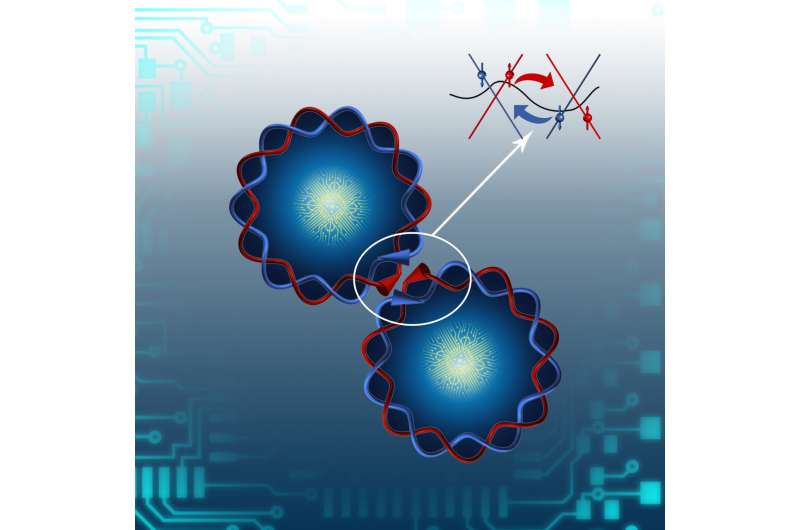The observation of 1D Coulomb drag between adjacent QSH edges separated by an air gap

Two important factors limiting Moore’s Law are power consumption and Coulomb interactions. Coulomb interactions are interactions between electric charges that follow Coloumb’s law, an electrodynamics theory.
These interactions can be a major challenge for the development of nanoelectronic circuits. Quantum spin Hall (QSH) insulators are particularly promising materials for the development of low-power electronics, yet so far the impact of Coulomb interactions on nanocircuits made by these materials have only been examined theoretically, rather than experimentally.
Researchers at Nanjing University and Peking University have recently observed one-dimensional (1D) Coulomb drag between adjacent QSH edges separated by an air gap. Their paper, published in Nature Electronics, highlights the potential of QSH effects for suppressing the adverse effects of Coulomb interactions on the performance of nanocircuits.
“The 1D dissipation-less helical edge state, which was observed in quantum spin Hall insulators could solve power consumption issues in integrated circuits,” Lingjie Du, one of the researchers who carried out the study, told TechXplore. “However, if two edge states are very close (~nanometer) in the circuit Coulomb effects may still affect circuit performance. To figure out the effect of Coulomb interactions between nearby edges, we designed and performed the Coulomb drag experiments reported in our paper.”
Firstly, Du and his colleagues realized an air gap across QSH edges in split H-bar devices placed in inverted InAs/GaSb quantum wells, using two techniques known as focused ion beam lithography and reactive ion etching. The air gap they created had the lowest possible dielectric constant, which produces strong Coulomb interactions.
“Through the air gap in split H-bar devices, we could observe 1D Coulomb drag in topological insulators for the first time and found that topological protections could suppress Coulomb effects between nearby edges.” Du said. “This is an important observation, as it means that we could use topological edges to construct integrated circuits.”
The recent study carried out by this team of researchers could have several important implications. First, the observation of 1D Coulomb drag in topological insulators could enable the development of more advanced integrated circuits that consume less power, while also reducing the spacing between circuit wires and potentially attaining a larger packing density of electronic devices on integrated circuits.
Du and his colleagues also observed the presence of the so-called Dirac point in 1D helical edge states for the very first time, reaching beyond the initial objective of their study. They found that near the Dirac point (i.e., point where linearly dispersing conduction and valence bands meet), negative drag signals dominate at low temperatures and exhibit a non-monotonic temperature dependence.
Essentially, this finding suggests that different drag mechanisms compete and cancel out at higher temperatures. In the future, the researchers’ findings could thus also improve the current understanding of the fundamental physics behind topological phases.
“The goal for many researchers in the field is to identify topological materials that can work at room temperature,” Du added. “With the right materials, it may become possible to connect electronics with topological wires, which should consume less power and enable higher packing densities than present technologies.”
Coulomb drag in topological wires separated by an air gap. Nature Electronics(2021). DOI: 10.1038/s41928-021-00603-y.
© 2021 Science X Network
Citation:
The observation of 1D Coulomb drag between adjacent QSH edges separated by an air gap (2021, July 5)
retrieved 5 July 2021
from https://techxplore.com/news/2021-07-1d-coulomb-adjacent-qsh-edges.html
This document is subject to copyright. Apart from any fair dealing for the purpose of private study or research, no
part may be reproduced without the written permission. The content is provided for information purposes only.
For all the latest Technology News Click Here
For the latest news and updates, follow us on Google News.

